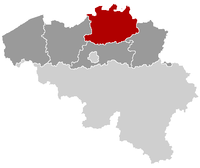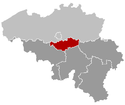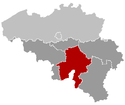Provinces of Belgium
Belgium is divided into three regions, two of them are subdivided into five provinces each.
The division into provinces is fixed by Article 5 of the Belgian Constitution. The provinces are further subdivided into arrondissements.
Contents |
Provincial government
The provincial government consists of three main parts: the Governor, an executive council known as the Permanent Deputation (Dutch: Bestendige Deputatie) in the Flemish Region, or as the Provincial College (French: Collège Provincial) in the Walloon Region, and the Provincial Council (Dutch: Provincieraad, the equivalent of a States-Provincial in the Netherlands), which is elected by the inhabitants of the province for a term of office of 6 years. The Permanent Deputations and the Provincial Colleges consist of seven members: the Governor and 6 Deputies elected by the Provincial Council from among its members. The numbers of seats in the Provincial Councils are proportional to the population of the province.
In Flemish Brabant, there is also a Deputy Governor (Dutch: Adjunct van de gouverneur). The Deputy Governor is appointed by the Flemish Government on the unanimous advice of the Federal Council of Ministers and must have a considerable knowledge of both the Dutch and the French language. He is responsible for ensuring that the language legislation is observed in the peripheral municipalities of Flemish Brabant.
Following the Fifth State Reform, the responsibility for the provincial institutions was devolved to the Regions. The Regions have the power to amend or replace the existing legislation on the provincial institutions, most notably the Provincial Law of 30 April 1836. In the Flemish Region the Provincial Decree of 9 December 2005 applies. In the Walloon Region, the Code of Local Democracy and Decentralisation applies. The legal framework in these Regions is still very similar, but that could change in the future. Although the Regions are responsible for the provincial institutions, the Federal State has retained its responsibility over the provinces in certain cases. For instance, the Regions are responsible for the appointment of the Provincial Governors, but only after the unanimous advice of the Federal Council of Ministers. Legislation regarding the Governor and Vice-Governor of Brussels-Capital, and the Deputy Governor of Flemish Brabant, has also remained a federal competency.
Absence of any province in the Brussels-Capital Region

The Brussels-Capital Region does not belong to any province, nor does it contain any. The extra-provincial status of Brussels has existed since 1995, when the former province of Brabant, which had Brussels as its capital, was divided into the Dutch-speaking province of Flemish Brabant and the French-speaking province of Walloon Brabant.
Within this region, nearly all former provincial competencies are assumed by its regional institutions and by the French Community Commission, the Flemish Community Commission or the Common Community Commission. However, the Arrondissement of Brussels-Capital has two commissioners of the Federal Government who are called 'Governor of the Brussels-Capital Region' and 'Vice-Governor'. The Governor exercises most of the few remaining powers elsewhere exercised by a provincial governor, particularly in the field of public order, as far as no (federal) law, (regional) decree, ordinance or decision states otherwise.[1]
The Governor is appointed by the cabinet of the Brussels-Capital Region on the unanimous advice of the Federal Council of Ministers. The regional government also appoints the Vice-Governor, who must have a considerable knowledge of both the French and the Dutch language and who must ensure that the legislation regarding the use of languages is observed in Brussels.[2]
Provinces of the Flemish Region
| Province | Antwerp | Limburg | Flemish Brabant | East Flanders | West Flanders |
| Dutch name | Antwerpen | Limburg | Vlaams Brabant | Oost-Vlaanderen | West-Vlaanderen |
| German name | Antwerpen | Limburg | Flämisch-Brabant | Ostflandern | Westflandern |
| French name | Anvers | Limbourg | Brabant flamand | Flandre orientale | Flandre occidentale |
| Location |  |
 |
 |
 |
 |
| Flag |  |
 |
 |
 |
 |
| Coat of Arms |  |
 |
 |
 |
|
| HASC[3] | BE.AN | BE.LI | BE.VB | BE.OV | BE.WV |
| FIPS[3] | BE01 | BE05 | BE12 | BE08 | BE09 |
| ISO 3166-2:BE[3] | VAN | VLI | VBR | VOV | VWV |
| Postal codes[3] | 2000-2999 | 3500-3999 | 1500-1999, 3000-3499 | 9000-9999 | 8000-8999 |
| Area | 2860 km² 21.15% of Flanders 9.38% of Belgium |
2414 km² 17.85% of Flanders 7.92% of Belgium |
2106 km² 15.57% of Flanders 6.91% of Belgium |
2982 km²[4] 22.12% of Flanders 9.81% of Belgium |
3151 km² 23.30% of Flanders 10.33% of Belgium |
| Capital[3] | Antwerpen | Hasselt | Leuven | Gent | Brugge |
| Population | 1,682,683 28% of Flanders |
805,786 13% of Flanders |
1,037,786 17% of Flanders |
1,389,199 23% of Flanders |
1,130,040 19% of Flanders |
| Density | 587 / km² | 333 / km² | 493 / km² | 459 / km² | 362 / km² |
| Governor | Cathy Berx | Herman Reynders | Lodewijk De Witte | André Denys | Paul Breyne |
| Government | CD&V, sp.a, VLD | CD&V, sp.a, VLD | CD&V, sp.a, VLD | CD&V, sp.a, VLD | CD&V, sp.a |
| website | www.provant.be | www.limburg.be | www.vlaamsbrabant.be | www.oost-vlaanderen.be | www.west-vlaanderen.be |
Provinces of the Walloon Region
| Province | Hainaut | Walloon Brabant | Namur | Liège | Luxembourg |
| French name | Hainaut | Brabant wallon | Namur | Liège | Luxembourg |
| German name | Hennegau | Wallonisch-Brabant | Namur | Lüttich | Luxemburg |
| Dutch name | Henegouwen | Waals Brabant | Namen | Luik | Luxemburg |
| Location |  |
 |
 |
 |
 |
| Flag |  |
 |
 |
 |
 or[5] or[5]
|
| Coat of Arms |  |
 |
 |
 |
 |
| HASC[3] | BE.HT | BE.BW | BE.NA | BE.LG | BE.LX |
| FIPS[3] | BE03 | BE10 | BE07 | BE04 | BE06 |
| ISO 3166-2:BE[3] | WHT | WBR | WNA | WLG | WLX |
| Postal codes[3] | 7000-7999 (West), 6000-6999 (East, shared with Luxembourg) |
1300-1499 | 5000-5999 | 4000-4999 | 6000-6999 (shared with Eastern Hainaut) |
| Area | 3800 km² 22.56% of Wallonia 12.44% of Belgium |
1093 km² 6.49% of Wallonia 3.58% of Belgium |
3664 km² 21.75% of Wallonia 11.99% of Belgium |
3844 km² 22.82% of Wallonia 12.58% of Belgium |
4443 km² 26.38% of Wallonia 14.54% of Belgium |
| Capital[3] | Mons | Wavre | Namur | Liège | Arlon |
| Population | 1,294,844 38% of Wallonia |
370,460 11% of Wallonia |
461,983 13% of Wallonia |
1,047,414 30% of Wallonia |
261,178 8% of Wallonia |
| Density | 341 / km² | 339 / km² | 126 / km² | 272 / km² | 59 / km² |
| Governor | Claude Durieux | Marie-José Laloy | Denis Mathen | Michel Foret | Bernard Caprasse |
| Government | PS, MR | PS, MR, Ecolo | PS, MR | PS, MR | PS, cdH |
| website | www.hainaut.be | www.brabantwallon.be | www.province.namur.be | www.provincedeliege.be | www.province.luxembourg.be |
Proposed 11th province (Eupen-Sankt Vith)
Because the German-speaking Community is located entirely within the Province of Liège, it has been proposed on multiple occasions to create an eleventh province, the Province of Eupen-Sankt Vith, which would comprise the 9 municipalities of the German-speaking Community. Most of the functions carried out by provincial organs would then be exercised by the organs of the German-speaking Community.[6][7]
See also
- Ranked lists of Belgian provinces
References
- ↑ Proposal for an ordinance, stating the Governor's powers for the "arrondissement Brussels", the latter should be seen as the part of the arrondissement Brussels-Halle-Vilvoorde that is not part of the Flemish Brabant province.
- ↑ "Factsheet on the Provinces" (PDF). The Belgian Chamber of Representatives. http://www.dekamer.be/kvvcr/pdf_sections/pri/fiche/28E.pdf. Retrieved 2007-06-22.
- ↑ 3.0 3.1 3.2 3.3 3.4 3.5 3.6 3.7 3.8 3.9 "Province of Belgium". statoids.com. http://www.statoids.com/ube.html.
- ↑ "Oost-Vlaanderen: feiten & cijfers". Provincie Oost-Vlaanderen. http://www.oost-vlaanderen.be/public/over_provincie/feiten_cijfers/index.cfm.
- ↑ The tricolour is official, but not in use. The many-striped flag is not official, but is in use."Luxembourg (Province of Belgium)". Flags of the World. March 21, 2009. http://flagspot.net/flags/be-wlx.html. Retrieved August 22, 2009.
- ↑ Ferdy Willems and Danny Pieters (21 March 2000). "Proposal of Law creating the Province of Eupen-Sankt Vith and a German-speaking electoral circle for the elections of the Chamber of Representatives and the Senate" (in Dutch and French) (PDF). The Belgian Chamber of Representatives. http://www.dekamer.be/FLWB/PDF/50/0524/50K0524001.pdf. Retrieved 2007-09-02.
- ↑ Jan Loones (VU) (13 July 1995). "Proposal of Law granting all provincial competences to the organs of the German-speaking Community and on the representation of the German language area in the Legislative Chambers" (in Dutch). The Belgian Senate. http://www.senate.be/www/?MIval=/publications/viewPubDoc&TID=16778258&LANG=nl. Retrieved 2007-09-02.
External links
- Vereniging van de Vlaamse Provincies (Association of the Flemish Provinces)
- Association des Provinces wallonnes (Association of the Walloon Provinces)
|
|||||||||||||||||||||||||||||||||||||||

